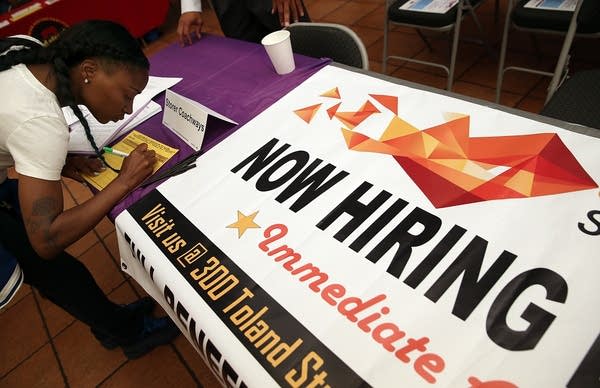US jobless rate dips to 6.1 percent; lowest rate since September 2008

Go Deeper.
Create an account or log in to save stories.
Like this?
Thanks for liking this story! We have added it to a list of your favorite stories.
U.S. employers accelerated their hiring last month, adding a robust 288,000 jobs and helping drive the unemployment rate to 6.1 percent, the lowest since September 2008.
• Twin Cities boasts lowest jobless rate among big U.S. metros
It was the fifth straight monthly job gain above 200,000 -- the best such stretch since the late 1990s tech boom. Over the past 12 months, the economy has added nearly 2.5 million jobs -- 208,000 a month, the fastest year-over-year pace since May 2006.
Friday's report from the Labor Department made clear that the U.S. economy is moving steadily closer to full health after having shrunk at the start of the year.
Turn Up Your Support
MPR News helps you turn down the noise and build shared understanding. Turn up your support for this public resource and keep trusted journalism accessible to all.
June's job gain followed additions of 217,000 jobs in May and 304,000 in April, figures that were both revised upward. Monthly job gains so far this year have averaged 230,833, up from 194,250 in 2013.
The unemployment rate dipped last month to its lowest level since the financial crisis struck at full force in the fall of 2008 with the bankruptcy of the Wall Street firm Lehman Brothers.
The gains were widespread. Factories added 16,000 workers. Retailers brought on 40,200. Financial and insurance firms increased their employee ranks by 17,000.
Job growth has averaged 272,000 over the past three months. In May, the economy surpassed its jobs total in December 2007, when the Great Recession officially began.
The number of long-term unemployed has dropped by 1.2 million over the past year to just under 3.1 million. That is half what it was three years ago.
Still, economists at the liberal Economic Policy Institute estimate that 7 million more jobs would have been needed to keep up with population growth.
The challenge is whether the job gains will pull more Americans back into employment and lift wages that have barely budged. Many people who lost jobs during the recession and were never rehired have stopped looking for work. Just 62.8 percent of adult Americans are working or are looking for a job, compared with 66 percent before the recession.
Average wages, meanwhile, have grown just 2 percent a year during the recovery, below the long-run average annual growth of about 3.5 percent.
Many economists predicted late last year that the steady but tepid recovery would accelerate in 2014. The steady gains over the past four years will finally unleash more hiring and higher wages, they said.
But the economy actually shrank in the first three months of this year at an annual rate of 2.9 percent. That's the sharpest quarterly contraction since the recession. Ferocious winter storms and freezing temperatures caused factories to close and prevented consumers from visiting shopping malls and auto dealers.
Still, the winter failed to freeze hiring and job growth has continued with little to no interruption. This should help to speed economic growth because more jobs lead to more paychecks to spend.
Most economists say annualized growth is tracking 3 percent to 3.5 percent in the current second quarter. Growth over the course of the entire year should be closer to 2 percent for the entire year, roughly similar to the 1.9 percent increase in gross domestic product achieved last year.
Other than the weak growth at the start of the year, several other signs point to the improving health of the economy.
Auto sales rose at the fastest pace in eight years in June. Dealers unloaded vehicles at an annual pace of 16.98 million last month. Factory orders picked up last month as well, according to a report this week by the Institute for Supply Management.
Home sales also strengthened in May, after having sputtered in the middle of last year when higher mortgage rates and rising prices hurt affordability.


